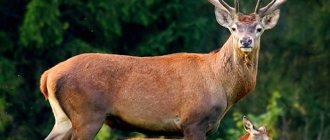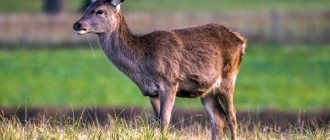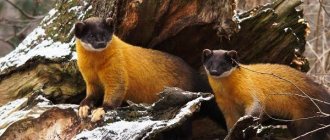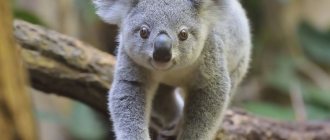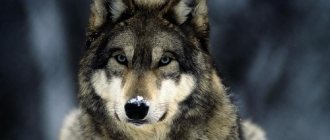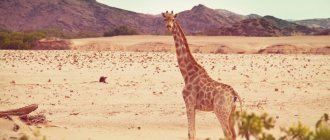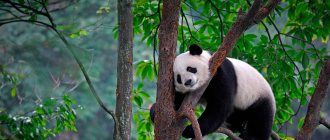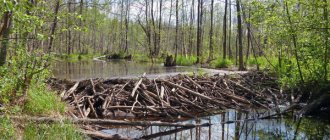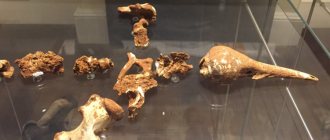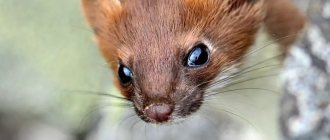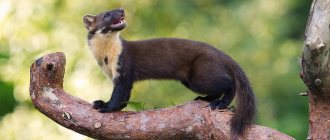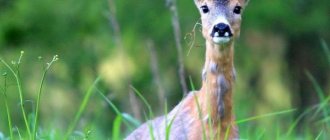Maral is a separate subspecies of the red deer species.
Red deer are shy and cautious animals. It is very difficult to see a deer in the forest. The maral, sensing a person, immediately disappears. Most likely, over many years these animals have developed an increased instinct of self-preservation.
Red deer (Cervus elaphus).
Males boldly enter into confrontation with predators. The main means of protection of deer are their strong hooves. Bears, wolves and large wild cats are afraid of these deer and try not to conflict with them.
The habitat consists of vast territories located southwest and south of the Caspian Sea. Due to the habitat of deer, they are often called Caspian deer.
Today, deer are bred in Asian and European regions because their horns are used for medicinal purposes.
Description and features
The owner of branched horns, the Altai maral belongs to the order of artiodactyls, the deer family. A large, powerful, hardy animal has a shoulder height of up to 155 cm, body weight reaches 300-350 kg and more.
The length from the withers to the tip of the croup is 250 cm. Cows are much smaller than males and lack horns. The fawns are larger than those of other members of the family; in the first week after birth, they weigh from 11 to 22 kg.
In summer, the color of individuals of both sexes is almost the same - uniform brown. In winter, bulls become grayish-brown, with yellow on the sides, darker on the belly, neck and shoulders. Females are uniformly gray-brown. The large "mirror" (a light circle of fur with a black border on the backside around the tail) extends to the rump and varies in color, ranging from dull rust to beige.
The horns of males are very large, without a crown, ending in six or seven branches. At the first branching point, the main rod bends sharply backwards. The head and mouth of this breed are large, especially compared to the Bukhara deer. The rumbling call is similar to the roar of the American elk, not the sound made by the European red deer.
Kinds
Altai maral is a subspecies of Wapitis from the deer family (Cervidae). Very reminiscent of American and North-East Asian wapiti, such as the Tien Shan breed (Cervus canadensis songaricus).
In 1873, the deer was described as a separate species. But a little over a century later, the animal was assigned to the Siberian group of red deer. Therefore, in some sources the animal is called “Siberian wapiti”.
Where does it live?
Hangul
The natural habitat of the species extends to almost all of Europe, western and central Asia, and the north-west of the African continent. Currently, the habitat of the deer has expanded significantly: the animal was introduced and successfully adapted to Australia, South and North America.
Where does he live?
The natural habitat of the red deer is deciduous forests, taiga, mountain meadows, coastal areas overgrown with reeds and other vegetation, and areas with numerous bushes.
Lifestyle and habitat
The Altai deer lives in the north-west of Mongolia, in the Sayan Mountains, in areas west of Lake Baikal, in the Tien Shan, in the Krasnoyarsk Territory, Kyrgyzstan and even in New Zealand, where antler reindeer husbandry is highly developed.
But most of all animals are in the Altai Territory. Only in deer breeding farms there are more than 85 thousand of them, and the total number in the Russian Federation and Mongolia is 300 thousand deer.
Mature deer prefer isolation or same-sex groups most of the year. During the mating season (rut), adult males compete for the attention of cows, and then try to protect the “subdued”.
For the rest of their lives, Altai deer are solitary, grazing in the foothills and wooded areas. Females and calves unite in small herds of three to seven animals, with a mature, experienced doe becoming the leader.
Dominant deer follow their mates from August to the end of November. “Veterans” often keep harems, the beast’s peak form occurs at 8 years of age. Deer aged from 2 to 4 years remain on the periphery of large harems.
Sick and old individuals (11 years or more) do not reproduce. Leader males roar to keep their subordinates together, a loud sound that reverberates throughout the area at dawn and late evening.
Deer graze among lush grass in the summer, and in autumn and spring they migrate in search of fertile areas at the foot of the mountains, sometimes covering long distances (up to one hundred kilometers), including water barriers. Representatives of this species of deer are excellent swimmers and are not afraid of mountain rapids. The coolness of the rivers saves bulls and cows when the summer is too hot.
In hot weather, they feed only early in the morning or after sunset, and rest in the shade of trees for the rest of the day. These are cautious, sensitive creatures, they move quickly, despite their impressive mass, and they take off at the sight of any danger. Easily conquers rocky areas.
Nutrition
The Altai maral is a herbivore. In spring, after a difficult cold winter, the need for vitamins and proteins increases. Young grass, cereals, legumes, and medicinal plants (for example, goldenseal) help deer gain strength. Deer love salt; they lick it to replenish the mineral balance from salt marshes. They enjoy drinking water from healing springs, including brackish ones.
Summer is a haven for horned giants. The grasses and flowers are tall and juicy, the berries are ripening, the forest is full of mushrooms and nuts that animals feast on. In early autumn, the diet of artiodactyls is still rich, but with the onset of cold weather they have to “go on a diet.”
If the snowdrifts are not too high, deer eat fallen leaves, found acorns, and get to the roots of plants. In cold weather, they gnaw bark from trees and bushes and tear off branches. Lichens and moss, as well as fir, spruce, and pine needles help deer survive until spring.
Since forest giants live and feed in protected and ecologically clean regions, Altai deer meat contains many vitamins and microelements. In particular, it includes potassium, magnesium, iron, glutamic and aspartic acids, riboflavin, thiamine, linoleic acids, selenium, sodium, vitamin PP, arginine. Therefore, deer meat is very healthy, removes toxins, strengthens the heart muscle, improves blood circulation, and minimizes cholesterol.
What do deer eat?
In the spring, deer feed mainly on grass while it is still green and lush. They pick grass quickly, up to 30 pinches per minute, and feed for an hour and a half, moving from place to place. When full, they lie down and chew the cud, almost like domestic cows. At this time, the young animals frolic under the supervision of adults. In the summer, when the grass grows, the deer tear off mostly the tops, without lowering their heads low to the ground, constantly looking around, and the herd is located so that everyone has a certain sector of view, but in general it turns out that the entire horizon is controlled. The deer rest in an open place so that everything around them can be seen.
By the way, deer are very fond of branches of bushes from the genus Ledum, growing in Altai, which is called “maralnik”. This shrub is very common in Altai. During the flowering of the maralberry, all the Altai mountains turn lilac-pink. This is simply an unforgettable picture. It is not for nothing that the time of flowering of maral in Altai is compared with the Hanami holiday in Japan. And although the marigold is scientifically called “Ledebourg rhododendron”, local residents do not know about it, but they have a sign: the marigold has bloomed - spring has come.
In winter, deer gladly eat branches and leaves of currants, willows, rowan trees, aspen, less often they eat honeysuckle or birch, and they do not refuse lichen, which they eat while shoveling snow, especially since there is an abundance of lichen in these parts. In farms that breed deer, they are fed more variedly; so-called hay stands and trays are placed in certain places. Therefore, if in the wild the deer usually lives no more than 15 years, then on farms they live up to 25-30 years.
Reproduction
Mating of deer is fraught with danger for the competing males. They challenge opponents by snorting and walking parallel to the enemy, allowing them to compare each other's horns, body size, and fighting prowess.
If neither one backs down, a duel with horns ensues. The males collide and try to knock the other down. The weaker ones leave the battlefield. You can tell if a fighter is strong not only by his appearance, but even by his voice. In a powerful person it is hoarse and “thick”, in a young person it is high.
Fatalities are uncommon, although deer can be killed if they get caught in their antlers. of Altai maral fighting are often seen in photographs, because at such moments the animals are absorbed in the fight. The rest of the time it is almost impossible to meet a deer in the forest, he is shy.
Females reach sexual maturity at 2 years, and usually give birth at 3. Bulls become fully ready for reproduction by 5 years. Cows can choose a partner by paying attention to body type and size of horns. If the female leaves the leader of the harem and finds a new “groom”, no one bothers them. Mating takes place more than once (up to 10-12 attempts) before fertilization occurs.
The gestation period is 240-265 days. Calves are born one at a time (rarely two at a time) at the beginning of summer or late spring, and then they are under the watchful, caring eye of their mother. The average weight of a newborn is about 15 kg.
Two months is enough for breastfeeding. Within two weeks after birth, the babies join the herd of adult females, although they stay close to their mothers for a year or a little less. At birth, babies are often spotted. These patterns go away after the offspring molt.
Antler baths
An absolutely amazing way to use deer antlers is antler baths , in which the properties of antlers are fully revealed.
While medicines based on horns have existed for a long time, baths for a long time were available only in maralniks - farms where antlers are harvested. Today, special concentrates are on sale, and you can take healing antler baths at home.
Antler baths have a rejuvenating effect on the skin, help remove toxins, perfectly relax after a hard day of work and improve blood composition.
- The use of antler baths is also recommended for diseases such as:
- cardiovascular (varicose veins, hypotension and hypertension);
- nervous system – neuroses, radiculitis;
- musculoskeletal system – osteochondrosis, arthritis, muscle strains;
- gynecological;
- skin problems.
You need to take such baths for 10-15 minutes, the treatment course is 10-12 baths every day or, if desired, every other day.
Lifespan
Altai deer are threatened by predators, but the prey is mainly young animals, animals weakened by disease or old age. Although wolves, tigers, wolverines, lynxes, and bears are not averse to eating venison, artiodactyls have powerful weapons; their horns look terrifying. Wolves hunt only in packs, as deer are not to be trifled with.
In nature, Altai giants do not live very long - up to 13-15 years. In specialized farms, with proper care, the life expectancy of deer doubles. Poaching damages the population, although hunting is regulated, deer are protected because they belong to rare species.
The modern humane approach to fishing (especially antlers) has led to the organization of reindeer farms, nurseries, and farms. There are especially many such enterprises in Altai, Kazakhstan, and New Zealand.
The blood of the Altai maral has been used in folk medicine since ancient times. In Asia, it was used in medicines for treatment more than five centuries ago - due to the content of vitamins, amino acids, hormones, steroids, and trace elements.
Another “elixir”, mined from time immemorial and used by Eastern healers (now production has been put on stream), is Altai deer antlers. These are not yet strong young “spring” horns: the tubes are filled with blood and covered with delicate hair.
Deer, like their closest relatives the deer, are capable of reproducing antlers. The hard and heavy burden is thrown off, and new ones grow in place of the old ones. Chinese experts consider antlers to be a miraculous raw material, comparable to ginseng.
In nurseries, antlers are cut from live deer and processed in several ways, choosing the most convenient:
- dried using vacuum;
- boiled and “dried” in the open air;
- placed in the freezer and dried at very low temperatures.
Finished antlers, which have lost about 30% of their original mass, are used for the production of an extract on a water-alcohol basis (used as a general strengthening and tonic) or biologically active additives.
Harvesting antlers takes a month - from the end of spring, when the animals' hormonal activity peaks and the antlers are soft (by the end of June they will harden). From one male you can get 25 kg of raw materials. The horns are cut off, the top of which has reached 5-8 cm.
Breeding deer in nurseries
The most common species found in artificial breeding nurseries is the Siberian deer, an animal of the Altai region. These areas are ecologically clean natural areas and are located far from industrial areas. Other conditions of the Altai Territory are also ideal: the optimal height above sea level for deer habitat and a good food supply.
Special farms are being created for reindeer breeding. The herds number hundreds of heads. The deer are not kept in pens, but on spacious pastures. These are large territories with special fences at the borders. Deer live, as in the wild, in small groups.
Deer that do not have processes on their antlers are shot, since such artiodactyls are capable of killing many rivals rather than maiming them, which significantly reduces the number of these animals.
Interesting Facts
- Snowy, long and harsh winters at the turn of the 20th and 21st centuries claimed the lives of almost 30% of Altai deer; they died due to avalanches, exhaustion and severe frosts;
- Young deer horns are used for antler baths; this procedure is offered in the sanatoriums of the Altai Mountains. 650-700 kg of raw materials are boiled in a large cauldron, so the concentration of nutrients in the bath is high;
- Altai deer served as inspiration for ancient artists. Samples of rock art depicting proud deer (petroglyphs) were found by modern researchers in the Kalbak Tash tract, near the Elangash River and in other parts of the Altai Territory. These are scenes of hunting, driving, as well as roaring giants with branchy horns;
- Siberian shamans have long considered deer to be guardian spirits, therefore during rituals they use tambourines made of deer skins with images of animals, hats with horns, imitate the behavior of males, roar and snort;
- The ancestors of Siberians thought that deer were guides to the other world, since during excavations of burial mounds, archaeologists discovered horse bones with large deer skulls on their muzzles. Therefore, the Altai deer is an animal that often appears in mythology along with its relatives, the wapiti.
Who discovered the magical properties of deer antlers?
The healing properties of antlers were mentioned in ancient Chinese mythology, where deer were revered as constant companions of the gods, and in the writings of an ancient Roman doctor. Later, deer antlers were widely used in Chinese and Korean healing systems.
They say that the ancient Chinese and Tibetans knew about deer antlers already 3 thousand years ago. Thus, in “Jud-shi,” the oldest textbook on Tibetan medicine, deer antlers are mentioned as a remedy that strengthens weakness and increases strength, as well as heals purulent wounds. But there is a possibility that the ancient inhabitants of Altai themselves knew about deer antlers and their therapeutic abilities.
The fame of the unique properties of antlers came to Russia in the 18th century, but they began to study the properties of this product in detail in the 30s of the 20th century. Since the end of the 19th century, deer have been bred in captivity to produce antlers; in Russia, this is primarily in the Altai Republic.
